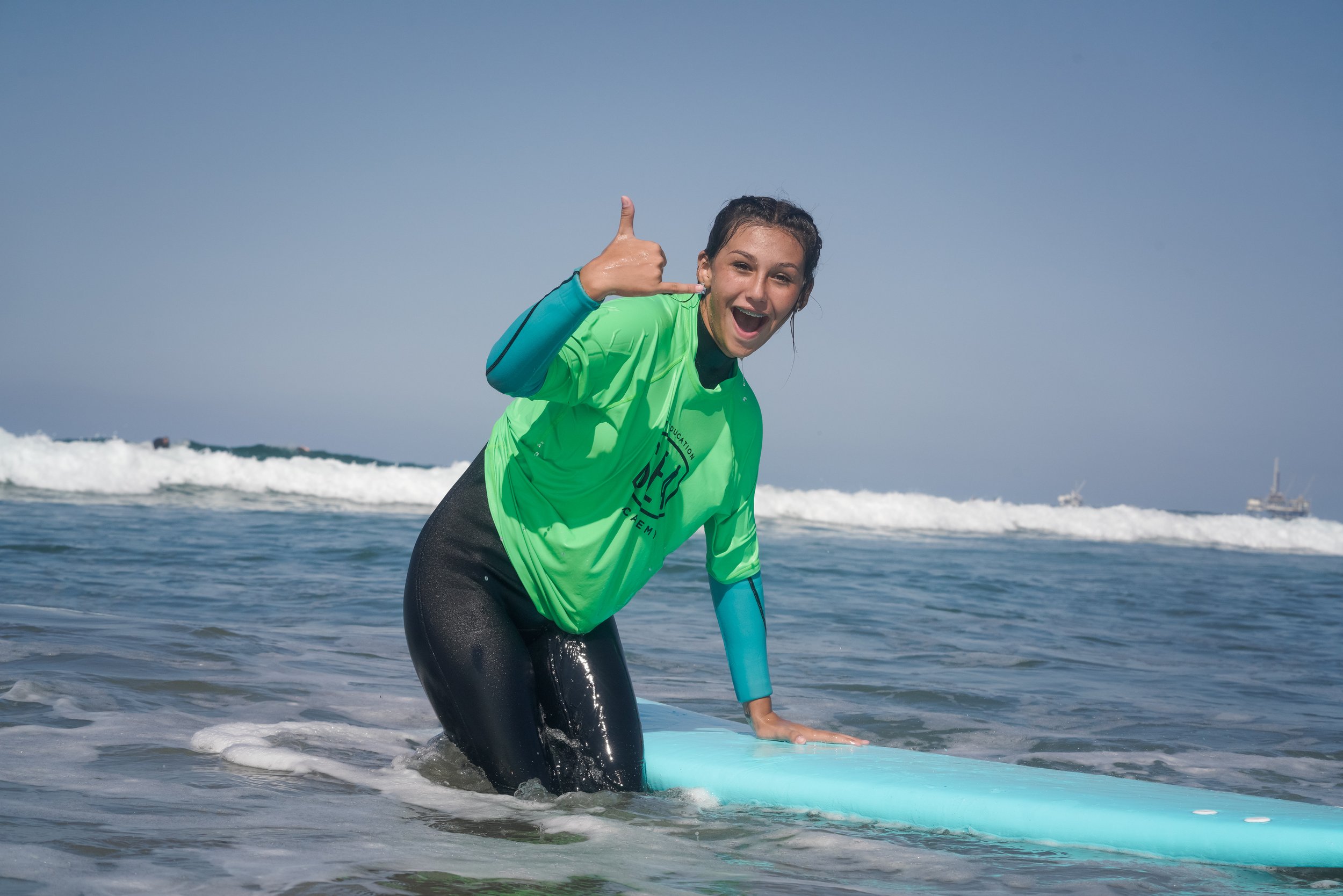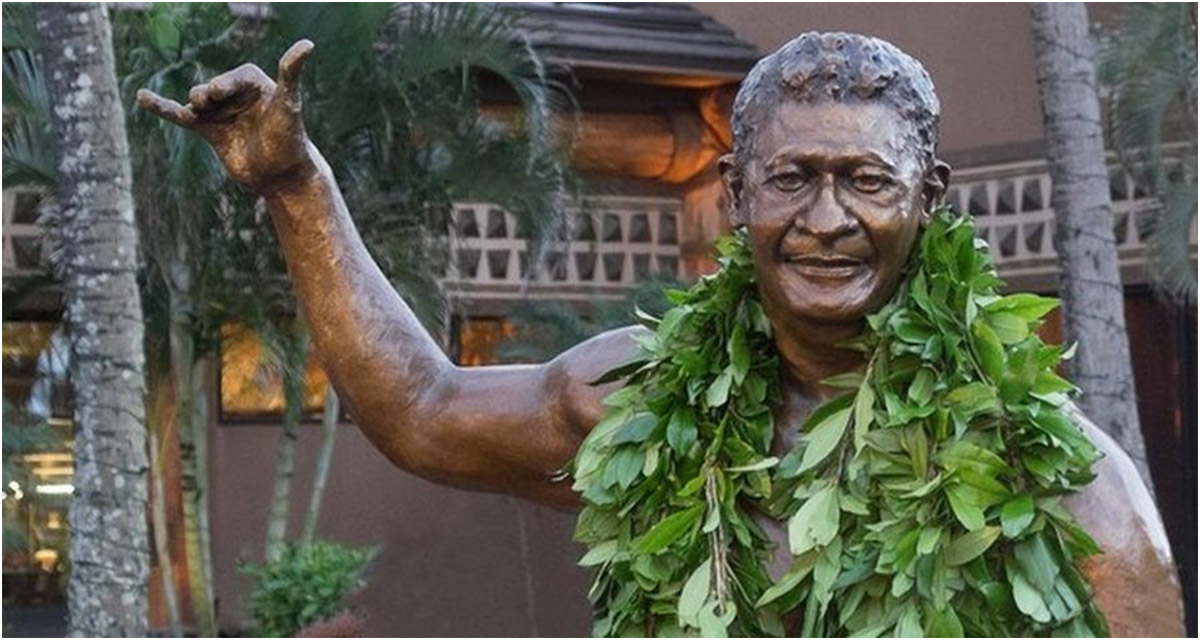
In the surf world, some things go beyond skill, equipment, and wave conditions. They’re part of the culture—unwritten traditions that bind the lineup together. The shaka sign—thumb and pinky out, middle fingers curled, sometimes with a gentle shake—is one of those universal bonds.
Whether you’re paddling out for dawn patrol at La Jolla Shores, cruising down Avenida de la Playa with your board in tow, or catching your first wave in a Surf Education Academy surf lesson, the shaka is more than just a hand gesture. It’s a sign of respect, connection, and pure stoke.
Let’s explore where it came from, what it means, and how it’s woven into both Hawaiian heritage and the heart of our La Jolla surf community.
What Is the Shaka?
To make the shaka:
- Form a fist.
- Extend your thumb and pinky.
- Curl your middle three fingers inward.
- Give it a loose, relaxed flick of the wrist.
That’s it. Simple in form, powerful in meaning.
In Hawaii, the shaka is a way to say aloha, mahalo, “hang loose,” or “all good.” It’s a silent thank-you to the driver who let you merge on Kamehameha Highway, a greeting between surfers sharing a peak at Waikiki, and a sign of solidarity in the lineup.
Here in La Jolla, it’s just as common—flashed by instructors sending off groms in summer camp, locals greeting each other on the boardwalk, and surfers signaling respect after a well-ridden wave.

The Hawaiian Roots — Hamana Kalili’s Story
The most widely accepted origin story takes us to early 20th-century Laie, Oahu, where a man named Hamana Kalili worked at the Kahuku Sugar Mill. A tragic accident took his three middle fingers, leaving him with only his thumb and pinky on one hand.
Kalili later became a security guard at a train station. His wave to passengers—naturally, a thumb-and-pinky salute—caught on quickly. Mischievous local kids (kolohe keiki) imitated his gesture to signal “coast is clear” when sneaking onto trains. Little did they know, they were sparking a global surf culture icon.
You can read more about Kalili’s life and the shaka’s cultural roots at the Polynesian Cultural Center.
How the Shaka Spread
The shaka got another boost in the 1960s and ’70s. Hawaiian TV personality David “Lippy” Espinda often ended commercials with a shaka and “Shaka, brah!” In politics, Honolulu mayor Frank Fasi used the shaka throughout his campaigns and formally credited Kalili as the originator.
As surfing exploded in popularity—especially with the California–Hawaii connection—so did the shaka. It became a part of the unspoken surfer code: a signal of gratitude for giving up a wave, a greeting in the lineup, or a celebration after a shared ride.
Shaka Is Worth a Thousand Words
A shaka is like a smile—you can give it to anyone, anywhere, and it’s almost always received warmly. But just like a smile, it comes in different styles.
- The Tight Shaka – Thumb and pinky stiff, middle fingers pressed hard against the palm. Often given by those new to surf culture. Friendly, but not quite “hang loose” yet.
- The Shaking Shaka – A vigorous back-and-forth motion. High-energy and enthusiastic, but sometimes overdone.
- The Loose Shaka – The gold standard. Elbow relaxed, thumb and pinky extended naturally, middle fingers curled but not tense. Delivered with calm confidence and a genuine smile.
Around La Jolla Shores, the loose shaka is king. Whether you’re thanking a surfer for letting you take a wave, acknowledging a lifeguard, or celebrating a friend’s ride, a relaxed shaka says it all: respect, stoke, and aloha.
Shaka in the La Jolla Surf Community
At Surf Education Academy, the shaka isn’t just a casual sign—it’s part of what we teach. Surfing is about more than learning to pop up on a board. It’s about understanding the culture and respect that make the lineup a community.
In our summer surf camps, you’ll see kids throwing shakas after their first ride, adaptive athletes using it to celebrate milestones, and instructors greeting students with one before paddling out. It builds camaraderie and reminds everyone that we share the ocean together.
Community is the backbone of resilience—both in and out of the water. In La Jolla, the shaka is a bridge between generations of surfers, a connection between locals and visitors, and a way of showing you belong here.
Aloha Spirit and Stoke
The shaka is inseparable from aloha spirit—a Hawaiian value rooted in kindness, unity, and mutual respect. In the water, that might mean letting a beginner catch a wave, sharing stoke after a great ride, or helping a stranger find the safest paddle-out channel.
It’s also tied to stoke, that deep feeling of joy and fulfillment surfers chase. Whether you’re threading a perfect right at Scripps or just standing up for the first time in whitewater, the shaka is how you share that moment with others.
For more on stoke and how surfing builds resilience, check out our other blogs.
Shaka Across the World
While its meaning is purest in Hawaii and surf communities, the shaka has been adopted worldwide—with some interesting variations:
- China – Identical to the shaka, but it means the number six, a lucky number symbolizing smoothness and good fortune.
- Spain, Russia, Germany, Ecuador, Chile – Used to signal “let’s have a drink,” with the pinky pointed outward like a glass to the mouth.
- Brazil – Often called “hang loose,” tied directly to beach and surf culture.
No matter where you see it, the essence remains—positive connection.
How to Throw the Perfect Shaka
- Relax – The shaka is all about looseness.
- Thumb and Pinky Out – Extend them naturally, no stiffness.
- Middle Fingers Curled – Keep them soft, not clenched.
- Add a Smile – It’s not just a hand sign; it’s a feeling.
- Shake (Optional) – A gentle flick if you want, but not required.
Like surfing, the shaka is best when it’s authentic. It’s not forced, not performative—it comes from genuine goodwill.
From Hawaiian Rails to La Jolla Shores
The shaka’s journey is one of cultural resilience. From Hamana Kalili’s sugar mill accident to becoming a symbol of surf culture, it’s a reminder that even challenges can create something beautiful.
Here in La Jolla, the shaka has found a new home. It’s part of surf school lessons, beach cleanups, adaptive surf programs, and everyday life. It’s exchanged between strangers who share a love of the ocean, between lifeguards and swimmers, between tourists who try surfing for the first time and locals who welcome them to the lineup.
FAQs About the Shaka Sign
Is the shaka only for surfers?
No. While it’s rooted in surf culture, it’s a universal sign of goodwill and can be used anywhere positive vibes are shared.
Do I have to shake my hand?
Nope. A loose, relaxed shaka without the shake is often more authentic.
What does it mean in La Jolla?
Here, it’s a sign of respect in the lineup, a welcome to newcomers, and a way of keeping the surf culture friendly and connected.
What’s the best time to use it?
Any time you want to acknowledge someone with kindness—whether it’s thanking another surfer, greeting a friend, or celebrating a shared win.
More Than a Gesture
The shaka isn’t just a hand sign—it’s a philosophy. It’s about recognizing we’re all part of something bigger: the waves we ride, the beaches we share, the moments of stoke that keep us coming back.
So next time you walk down to La Jolla Shores, paddle out at Scripps, or catch that first peeling wave at Windansea, remember to share a shaka. It’s more than a gesture—it’s your invitation to the tribe.
Ready to learn the culture as well as the sport?
Join us at Surf Education Academy in La Jolla. We’ll teach you how to ride waves—and how to share the aloha spirit that makes surfing unforgettable. Your first wave and your first shaka are waiting.


 Riding the Waves of Life: How Surfing Builds Resilience and Strengthens Mental Health
Riding the Waves of Life: How Surfing Builds Resilience and Strengthens Mental Health